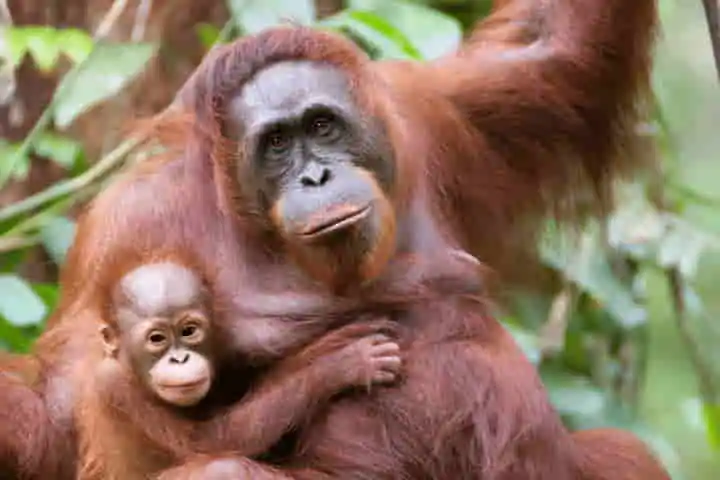In an interesting study, researchers have found that call signals of orangutans travel over long distances through green cover of forest, without dropping the meaning of the communication. The University of Warwick researchers feel that this brings into question the evolution of human speech as depicted by a mathematical model.
Evolved by mathematicians, in the model which is at present accepted, it is stated that ancestors of human beings strung sounds in their calls with the aim of carrying the content of their signal to reach over a larger distance to the recipient. As the quality of the signal deteriorated while travelling over long distances, the humans began connecting sounds together so that the package of information intended to be conveyed would reach, even if there is distortion in it.
Belonging to the University’s Department of Psychology, these researchers started collecting empirical data to explore the model. A range of sounds were selected from the audio recordings of orangutan communications that had been collected previously.
Now the scientists played out specific vowel-like and consonant-like signals which were recorded again at certain set distances like 25, 50, 75 and 100 metres. Thereafter, both the content and quality of the signals which had been received were analysed.
Also read: Domestic Cats Hunt To Satisfy Their Killer Instinct And Not For Food
What was found by analysing has been published in Biology Letters under the title "Orangutan information broadcast via consonant-like and vowel-like calls breaches mathematical models of linguistic evolution,” according to an article in smithsonianmag.com.
What was deduced by the research team was that even though there was a deterioration in the signal quality, its content remained intact, even over long distances. What was truly amazing was that the calls’ informational characteristics remained uncompromised till the signal became inaudible.
This brought into question the existing and accepted theory of language development.
Elaborating on the study, its leader, Dr Adriano Lameira who is an evolutionary psychologist from the University of Warwick, said: “We used our bank of audio data recordings from our studies of orangutan in Indonesia. We selected the clear vowel-like and consonant-like signals and played them out and re-recorded them over measured distances in a rainforest setting. The purpose of this study was to look at the signals themselves and understand how they behaved as a package of information. This study is neat because it is only across distance that you can hope to assess this error limit theory — it disregards other aspects of communication like gestures, postures, mannerisms and facial expressions.”
Lameira went on to add: "The results show that these signals seem to be impervious to distance when it comes to encoding information. It calls into question the existing thinking based on the model set out 20 years ago by Harvard scientists. Their work assumes that the signals that our ancestors were using were reaching an error limit — a moment when a signal is received but stops being meaningful. They concluded that our ancestors linked sounds together to increase the chance of content travelling over distance.”
Delineating more on this issue, the evolutionary psychologist stated: "We know sound degrades the further away from the source you are. We have all experienced this effect when shouting for your relative or your friend. They don't hear all the words you say — but they recognise you are talking to them and that it is your voice. By using actual great ape communication sounds, which are the closest to those used by our hominid ancestors, we have shown that although the sound package is being distorted and pushed apart, the content remains unaltered. It's a call to the scientific community to start thinking again about how language evolved."
The reason orangutan’s calls were used for this study was because they were the first species to diverge from the ape lineage and also the only ones to use consonant and vowel like sounds, that too in a complex style and manner. Thus they provide a parallel with human speech.
Also read: Why do humans not have tails – scientists solve the riddle
The next stage that his team wants to move to is to study and decipher the meaning of the calls of the orangutan. This will be done by pulling together the ways the creature combines the calls, putting the sounds of vowel and consonant in unison to get meaning.
The evolutionary psychologist added: "We still don't know what they are referring to, but right now what is completely clear is that the building blocks of language are present. Although other animal sounds and signals are complex, they are not using the same building blocks. We are focussed here on the building of language — exactly the component the great apes use. It gives us the parallel to human language.”
Talking about the Harvard model, he said: "The Harvard model has been the accepted theory for years and if you ask a mathematician if language origins were still a puzzle they'd say no — but evolutionary psychologists are still working on it. But we haven't solved the puzzle either — if anything we have just gone deeper down the rabbit hole. We are proposing that mathematical models be applied to the real life data to see what we can come up with together."




















